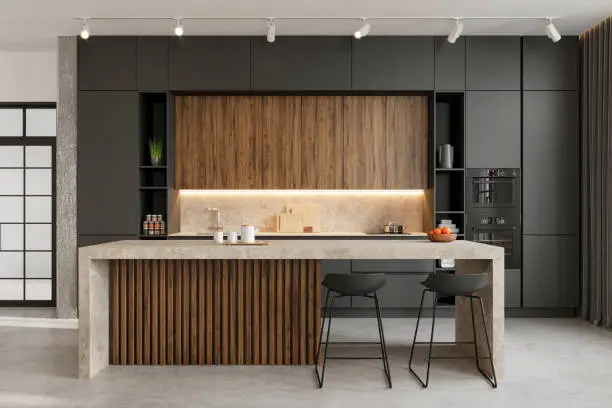Concrete has experienced a remarkable transformation in recent years, evolving far beyond its humble origins as a basic construction material. Today, it stands as one of the most adaptable and visually dynamic options for anyone looking to elevate the aesthetic and functionality of their home. Creative homeowners and forward-thinking designers alike are pushing the boundaries, using concrete to craft living spaces that radiate sophistication, innovation, and enduring appeal. Whether you’re yearning to infuse an industrial flair or a minimally modern atmosphere into your home, concrete allows you to achieve your vision with ease. Collaborating with skilled professionals such as Concrete Roseville ensures that your project is handled with expert craftsmanship and modern techniques, delivering lasting results. By embracing the full range of concrete’s capabilities, you can dramatically enhance not only your home’s style and value but also its resilience and personalized charm. With a multitude of creative applications—ranging from seamless kitchen counters and radiant floors to alluring outdoor features—concrete’s role in modern design is steadily expanding. The options for customization are virtually endless, making a unique and revitalized space more attainable than ever before.
Concrete Countertops
Concrete countertops have quickly become a centerpiece in contemporary kitchens and bathrooms. Offering unmatched customization, these countertops can be tailored to fit any space, personality, or design vision. The ability to adjust shape, thickness, inset color, and finish means that whether your palette is bold and dramatic or soft and organic, your countertop will be truly one-of-a-kind. Homeowners appreciate the endless design opportunities, from incorporating recycled glass and decorative stones to embedding personal items or achieving intricate surface patterns.
In addition to their visual impact, concrete countertops are celebrated for their hardiness. Naturally resistant to heat and equipped to handle heavy, everyday use, they outperform many traditional countertop materials in terms of longevity. Their capacity to withstand hot pans, sharp blades, and the rigors of busy kitchens makes them a practical investment. To retain their striking appearance, a simple regimen of sealing and basic upkeep is all that’s needed to protect from staining and scratching, ensuring that these countertops maintain their elegance for many years.
Polished Concrete Flooring
Polished concrete floors have soared in popularity due to their inherent blend of elegance, function, and practicality. The professional grinding and polishing process transforms bare concrete into a silky-smooth, reflective surface that immediately elevates the atmosphere of any room. These floors make interiors appear brighter and more spacious by reflecting natural and artificial light, creating an airy and open ambiance. Those designing with contemporary, industrial, or even rustic themes will find polished concrete effortlessly integrates with diverse decor styles.
Durability is a defining characteristic of polished concrete flooring. This surface is highly resistant to scratches, abrasions, and moisture, making it an excellent choice for high-traffic areas such as entrances, kitchens, and living rooms. Unlike many other flooring materials, polished concrete doesn’t require elaborate maintenance—frequent sweeping and the occasional damp mop are typically sufficient to preserve its gleam. With the option to introduce vibrant stains, tints, or decorative scoring, polished concrete can mimic the appearance of luxury marble or natural stone, or display geometric patterns for a truly customized floor.
Concrete Furniture
The use of concrete in furniture design has unleashed a wave of innovation, bringing stunning, statement-making pieces to interior and exterior settings. Contemporary artisans are crafting everything from monolithic dining tables and sophisticated benches to artistic coffee tables and sculptural planters that double as focal points in a room. Thanks to concrete’s ability to be molded and cast, furniture pieces can incorporate sweeping curves, integrated storage, or unexpected design twists, explicitly tailored to your taste and environment.
Concrete furniture doesn’t have to be cold or austere. Pairing these robust pieces with reclaimed wood, lush textiles, or natural fibers softens their visual presence and ensures comfort without sacrificing style. This harmonious blend of rugged and refined materials creates inviting and liveable spaces, whether you’re designing a cozy indoor nook or a lavish garden retreat. Concrete furniture stands out for its artistic flair, impressive longevity, and weather-resistant qualities, making it ideal for indoor and outdoor living.
Decorative Concrete Walls
Homeowners and designers increasingly choose concrete for feature walls—using it as a canvas to evoke depth, texture, and striking architectural interest. Thanks to various advanced techniques, today’s decorative concrete can be stamped to mimic natural wood or lavish stone, stained in vibrant hues, etched with geometric or organic motifs, or embedded with shells, stones, or even LED lighting. Approaches like Venetian plaster, micro-topping, or faux finishes allow for the luxurious look of fine tile or marble, often at a more affordable price point and requiring less maintenance.
Beyond captivating design, concrete walls offer functional benefits. Leveraging the natural thermal mass of concrete, these walls help regulate indoor temperatures, retaining heat during cooler months and releasing it as the home warms. This passive energy efficiency is valuable, contributing to reduced utility bills and a more consistently comfortable living environment. As homes increasingly move toward open-concept layouts and sustainable renovations, concrete walls are ideal for those seeking style and brilliant performance.
Eco-Friendly Concrete Options
The drive for sustainable building solutions reshapes how concrete is produced and used in the home. Modern eco-friendly concrete incorporates recycled aggregates—such as crushed glass, post-consumer plastics, and leftover industrial materials like fly ash or slag—without compromising performance. These forward-thinking mixes conserve natural resources and reduce the amount of construction waste headed for landfills.
Environmentally conscious homeowners also turn to low-carbon or carbon-neutral blends that harness supplementary cementitious materials (SCMs) or newly developed carbon capture technologies. These advances substantially shrink the material’s traditional carbon footprint, making it possible to design beautiful spaces while aligning with green building standards. Permeable concrete surfaces, which allow stormwater to filter into the ground naturally, further support eco-friendly landscaping and minimize harmful runoff—an approach gaining traction in regions dedicated to water stewardship and climate resilience. For more on sustainable design, consider exploring insights at Consumer Energy Center. The potential of concrete as a creative and eco-conscious design solution is genuinely astonishing. From polished floors that exude luxury to thoughtfully engineered countertops and outdoor features, concrete empowers homeowners to express their style while improving their living spaces.








Leave a Reply